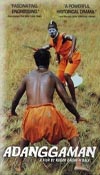
The DVD box cover lists this as a Swiss-Cote d'Ivoire co-production. It's the most recent of six films by director Roger Gnoan M'Bala, about whose earlier work over 36 years IMDB has little to say. The present picture is a period piece, set in the 17th century. Its hero is Ossei. a rebellious son who resist his father's pressure to enter into an arranged marriage. Ossei would rather romance a slave girl, to the annoyance of his snobbish dad and other village elders who ambush Ossei and beat him up after one tryst too many. Understandably, Ossei promptly says good-bye to the village. As a result, he misses a raid that razes the village. Seeing the flames, he rushes back to find his father and girlfriend, among others, dead, and everyone else missing. His mother, the outspoken Mo Akassi, and the other survivors have been enslaved by an army (including a cohort of orange-clad, face-painted women warriors) of Adanggaman, who has set himself up as a local emperor. Ossei actually manages to rescue his mother, but one of the women warriors catches up to them. She fights with a whip and a dagger. Ossei manages to take the whip from her, but while he's probably stronger, she has better skills and the dagger. She wounds him in the arm and leaves him for dead, taking Mo Akassi back to the slave caravan.
Ossei perserveres and makes it to Adanggaman's town, where the despot lords it over his vassals. He revels in tribute but rebukes an underling who took it upon himself to massacre an enemy tribe. Only Adanggaman gets to decide who lives, dies, or is enslaved! Some are sold to local villages, others to Europeans in exchange for rum and other goods. Ossei watches while Adanggaman inspects his new captives and gets a mouthful from Mo Akassi. When he renames her "Botimo" or monkey, she tells him he's the monkey because he's insatiable for everything. Meanwhile, an old healer finds Ossei and gets him out of harm's way. Ossei decides to turn himself in, hoping the emperor will free Mo Akassi in exchange. But there's no dealing with Adanggaman. In time, we learn that the healer's daughter, Naka, is the warrior woman who had fought Ossei earlier. Now she has an attack of conscience over her father's fate. She turns deserter, frees Ossei, and flees with him, hoping to start a new life together. Their idyll proves all too brief....

Adanggaman (center, with bone) presides over his kingdom in his very own movie.
Adanggaman is a grim affair, as is only appropriate. African enslavement was an atrocity the horror of which would be undermined if we had a story with a happy ending of escape. M'Bala makes a very smart decision right away by creating a family conflict that any audience could identify with, creating instant identification with Ossei and lending a bitter irony to his father's death. M'Bala's direction is pretty straightforward. There's no stylized action, and a lot of it is filmed at a distance so the audience will keep its distance, too. The exception is the initial fight between Ossei and Naka, and that's free of the sort of choreography that would be inappropriate here. One could easily imagine an Americanization of the story that would make Naka more of an "Amazon" (as the box cover calls her) than she really is, while Ossei would be more like the heroes of Apocalypto or 10,000 B.C. But that approach would obscure the mass reality behind an individual triumph. As M'Bala informs us in a closing title card, even Adanggaman himself would be caught in the net of the slave trade. There are no winners in this story.
New Yorker Films was clearly concerned about the potential for controversy in a film about Africans enslaving Africans. The DVD comes with a little "Historical Context" feature that makes pains to emphasize that no one should jump to the conclusion from a viewing of Adanggaman that blacks deserved what they got in America because of the way they treated each other. It's kind of sad that someone had to state the obvious, but I can understand why they did. You can check it out here. I don't know if African filmmakers have done anything dealing with the other end of the Atlantic trade, but if not, this would make a good first half of a double-bill with Jacopetti & Prosperi's Addio Zio Tom.
Once more, I have to give credit to the Albany Public Library for making this film available for me. They have several more African films in their collection which I'll be sampling during the year, along with faster-growing collections of Spanish-language and Bollywood movies. I'm extravagant in my DVD purchasing habits, but I'd be unable to fulfill my mandate of describing a wild world of cinema without the library's extraordinary holdings.
No comments:
Post a Comment